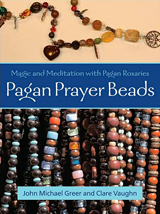The word "rosary" conjures up an image of devout elderly women in long black veils telling their beads in the pews of Catholic or Greek Orthodox churches. The phrase "prayer beads" gives rise to thoughts of Buddhist monks, malas in hand, chanting the verses of sutras and keeping count by means of their beads. Yet today, many American pagans are using rosaries or prayer beads as they pray, meditate, or chant spells.
Rosaries, or strings of prayer beads, originated in India, where yogins and yoginis were using what is still the standard Hindu mala (literally "rose" or "garland") before the 8th century BCE The traditional 108 identical beads of the malas, usually made from the seeds of sacred plants, helped Hindu mystics focus their minds while chanting mantras, the sacred syllables of power central to Indian spiritual and magical practice. Buddhist monks and nuns borrowed the mala early on, possibly during the life of the Buddha himself. Buddhist missionaries spread the mala throughout Asia, and, to this day, it remains a fixture of spiritual practice throughout the Far East.
Buddhism also brought the rosary westward. Buddhist missionaries reached Alexandria in Egypt, the intellectual center of the old Mediterranean world, by the 2nd century BCE, and established monasteries throughout central Asia and the eastern parts of what we now call the Middle East. As the newer religions of Christianity and Islam came into contact with Buddhism, they borrowed the rosary as well, though they changed its design to fit their own number symbolism. The Muslim rosary has ninety-nine beads, representing the ninety-nine names of God, and one larger bead representing the deity himself. The oldest Christian rosary has 150 beads, representing the 150 psalms, and is still used today by Benedictine monks. The most common rosary among Catholics nowadays, the fifty-bead Marian rosary, was created by St. Dominic in the early 13th century CE after experiencing a vision of the Virgin Mary.
As far as anyone knows, pagan religions in the Western world didn't use rosaries before the arrival of Christianity. Modern pagans recognized a good thing when they saw it, however, and, just like the Buddhists, Christians, and Muslims before them, have adopted the practice and reshaped it to fit the needs of their own faiths. Go to a pagan gathering and you'll find at least one vendor selling beads: a witches' ladder, a Triple Goddess or Full Moon rosary, wrist rosaries for meditation, or rosaries made of specially chosen stones to carry out magical purposes. In the last few years, pagan rosaries have begun to gain popularity, and are now poised to come into their own.
One remarkable difference sets most pagan rosaries apart from their historical predecessors. Hindu, Buddhist, Christian, and Muslim prayer beads usually have a set number of identical beads, with at most one or two specialized beads serving specific functions in prayer, meditation, and ritual. By contrast, most modern pagan rosaries include beads of many different shapes, sizes, and colors, and often have a rich diversity of charms, pendants, and other decorations as well. It's rare to see two pagan rosaries that are exactly alike—and this is exactly as it should be. Modern pagan spirituality values diversity and treasures the uniqueness of the individual, so it's perfectly appropriate that pagan rosaries should be as unique, diverse, and creative as pagans themselves.
Pagan Prayer Beads » Pagan Prayer Beads: Magic and Meditation with Pagan Rosaries
John Michael Greer and Clare Vaughn (2007) Red Wheel/Weiser, LLC
